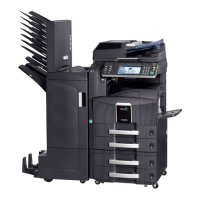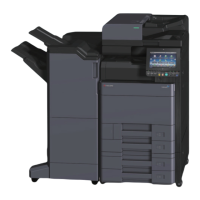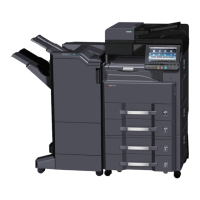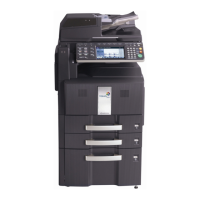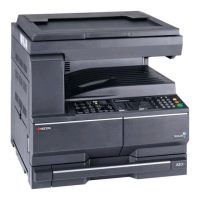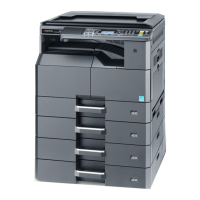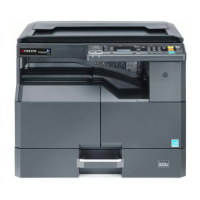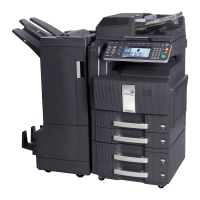Why is there no print output after reception on my Kyocera Fax Machine?
- EEmily PerkinsSep 4, 2025
If there's no print output after reception on your Kyocera Fax Machine, check if memory forwarding is activated and verify the forwarding destination.






Why is there no print output after reception on my Kyocera Fax Machine?
If there's no print output after reception on your Kyocera Fax Machine, check if memory forwarding is activated and verify the forwarding destination.
Why Kyocera Fax Machine cannot receive 2 in 1 reception?
If your Kyocera Fax Machine cannot receive 2 in 1 reception, cancel the duplex printing.
Why Kyocera Fax Machine cannot use the remote switching function?
If your Kyocera Fax Machine cannot use the remote switching function: 1. If a pulse line is used, some phones may transmit tone signals using buttons. Refer to the operation manual of your phone set. 2. Check if the remote switching number is correct (Default: 55). 3. Ensure you press the remote switching number twice slowly.
What to do if Kyocera Fax Machine cannot perform memory forwarding?
If your Kyocera Fax Machine cannot perform memory forwarding, check the memory forwarding setting to ensure it is set to [On].
Why Kyocera Fax Machine cannot perform memory forwarding using a sub address?
If your Kyocera Fax Machine cannot perform memory forwarding using a sub address, it might be because the recipient fax machine does not have a sub address transmission feature. Sub address transmission cannot be performed unless the recipient fax machine has a similar sub address transmission feature. Also, ensure that the entered sub address is identical to the sub address registered in the recipient fax machine; if your entry is correct, check with the recipient.
| Print Speed | 45 ppm |
|---|---|
| Standard Paper Capacity | 1, 150 sheets |
| Functions | Print, Copy, Scan, Optional Fax |
| Maximum Paper Size | 12" x 18" |
| Duplex Printing | Standard |
| Copy Speed | 45 cpm |
| Copy Resolution | 600 x 600 dpi |
| Print Resolution | 600 x 600 dpi |
| Memory | 2 GB RAM |
| Hard Disk Drive | 320 GB |
| Connectivity | USB |
| Control Panel | Color Touch Screen |
| Scan Resolution | 600 x 600 dpi |
| Fax Resolution | 400 x 400 dpi |
| Type | Multifunctional |
Introduces the operation guide and lists its chapters.
Describes keys and indicators on the operation panel for fax functions.
Identifies external parts of the machine used as a fax.
Details the parts of the document processor for scanning originals.
Guides through initial fax system setup using a wizard.
Explains how to register the machine's internal date and time for accurate fax operations.
Covers registering, searching, and managing fax destinations in the address book.
Explains how to register and use one-touch keys for quick access to destinations.
Details the usage of the Enter and Quick No. Search keys on the operation panel.
Explains the general process of sending faxes using numeric keys and transmission methods.
Describes how to configure the machine for automatic reception of incoming faxes.
Provides procedures for canceling various types of fax transmissions and communications.
Explains how to select a registered destination from the address book for fax transmission.
Describes how to use speed dial keys to select fax destinations.
Explains automatic and manual redial functions for contacting busy or unresponsive numbers.
Details how to display a preview image of a scanned original before sending.
Introduces the quick setup screen for accessing frequently used fax send settings.
Explains how to add and manage shortcuts for frequently used functions in the quick setup screen.
Describes scanning and sending fax originals that are longer than standard sizes.
Explains how to schedule fax transmissions to occur at a preset time.
Details sending the same originals to multiple destinations in a single operation.
Allows scanning originals and scheduling the next transmission during an ongoing communication.
Enables sending urgent originals during a prolonged communication or scheduled transmission.
Explains dialing by linking fax numbers with a common chain number for cost-effective international calls.
Describes sending originals after manually confirming the connection to the receiving system.
Explains how to manually receive faxes by pressing a button after confirming the connection.
Allows starting fax reception by operating a connected telephone set.
Covers forwarding received faxes to other destinations based on specified requirements.
Details storing received originals in the machine's FAX Box for later retrieval.
Explains communication using sub addresses and passwords for confidential delivery and polling.
Allows registering transmission requirements as programs for easier recall.
Describes a mode where the receiving machine controls original transmission from the sending machine.
Restricts direct entry of fax numbers, allowing only address book or one-touch key destinations.
Covers user management and job accounting to control machine usage per account.
Introduces various helpful functions for sending faxes, such as size and orientation settings.
Lists tools available for checking fax transmission outcomes and system settings.
Explains how to view the history of send and receipt results for the latest 100 jobs.
Details how to print various reports like send results, RX results, and activity logs.
Describes configuring the machine to notify fax receipt results via e-mail.
Explains the screen that appears to confirm destinations before sending a fax.
Guides selecting the appropriate telephone line type for fax transmission.
Explains how to select whether and where TTI information is printed on received faxes.
Covers registering Local FAX Name and Local FAX Information/ID for TTI.
Details the ECM (Error Correction Mode) setting for transmitting data to prevent distortion.
Explains setting the transmission speed, adjustable for poor communication conditions.
Describes how the machine handles calls from telephones and faxes on a single line.
Explains how the machine integrates with an answering machine for handling calls.
Allows adjustment of the number of rings before answering a call for different reception modes.
Covers adjusting the volume for the speaker and monitor on the machine.
Sets whether an audible signal is generated upon job completion.
Allows changing the number of automatic retries for failed transmissions.
Explains the different modes available for receiving faxes automatically or manually.
Adds reception date/time and sender info to printed faxes for confirmation.
Specifies the paper type to be used for printing received faxes.
Allows selection of the MP tray for printing received faxes.
Details the ECM setting for receiving data to ensure image quality.
Explains setting the reception speed, adjustable for poor reception conditions.
Describes using Distinctive Ring Pattern service to differentiate between fax and telephone calls.
Restricts fax communication based on registered permit/reject numbers and IDs.
Enables secure communication of originals using encryption keys.
Allows reducing print size when the received fax is larger than the paper size.
Enables printing received faxes on both sides of the paper.
Prints two pages of an original onto a single sheet of paper.
Allows service centers to remotely access the machine for troubleshooting.
Sets a time period during which the machine will not print received faxes.
Configures the output tray for printing received faxes.
Introduces the optional kit for using Internet FAX functionality.
Describes increasing image memory size and storage capacity for originals.
Explains the benefits of using two phone lines for faster and simultaneous fax operations.
Restricts access to specific ports when job accounting is enabled.
Explains the concept of i-FAX, sending and receiving faxes over the Internet.
Covers configuring SMTP, POP3, and other network settings for i-FAX.
Details the process of sending faxes using the i-FAX function via email addresses.
Explains how the machine receives i-faxes automatically by connecting to a mail server.
Describes Network FAX functionality, enabling PCs to send/receive faxes via the machine.
Outlines the necessary preparations for using Network FAX, including PC connection and driver installation.
Provides step-by-step instructions for installing the Network Fax Driver on a PC.
Explains the procedure to remove the Network FAX Driver from a computer.
Covers the fundamental process of sending a fax from a PC using the Network FAX driver.
Details how to modify fax transmission settings like destination and cover pages.
Explains how to select, attach, and transmit cover pages with faxes.
Describes registering default cover pages to omit selection for each transmission.
Allows verification and termination of fax transmissions currently being processed from a computer.
Explains the meaning of the machine's indicators during fax transmission and reception.
Provides essential precautions to take before turning off the main power switch.
Lists common error messages and their corrective actions for problem identification.
Offers solutions for various symptoms and problems encountered during fax operation.
Explains how to enter characters using the on-display keyboard for names and other inputs.
Lists the technical specifications of the fax machine, including compatibility and transmission speeds.
Provides a comprehensive list of menus and functions accessible on the touch panel and operation panel.
Details paper priority for matching received fax sizes when loaded paper does not match.
Details paper priority for matching received fax sizes for metric paper sizes.
Provides a reference for error codes recorded in TX/RX reports and their possible causes/actions.


